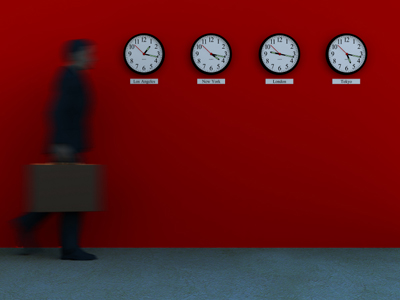This Spanish Easy Review math quiz challenges you on time. "What time is it?" is probably one of the most frequently asked questions in any language because everyone wants to know the time. As a child, you start to learn how to tell the time somewhere between the first grade and the second grade. Now, however, you are about to learn what time it is in Spanish. To start off, you first need to know how to ask what time it is in Spanish. To do that, you will need to learn one new vocabulary word and that is the word for hour. In Spanish that is [la] hora. The second thing you need to learn is that the question can be asked in two different ways.
Those two ways are:
¿Qué hora es?
¿Qué horas son?
Notice that the 'to be' verb used here is ser. The verb ser is always used when telling the time of the day, the day of the week, the month of the year and the date. So why are there two ways to ask?
In English we ask for the time of the day by asking, 'What time is it?' In Spanish you ask, 'What hour is it?' [¿Qué hora es?] or 'What hours are they?' [¿Qué horas son?] As there are 24 hours in a day and not just one hour, making 'hours' plural seems appropriate. However, although each version is used, the more frequently used question is that of ¿Qué hora es?
Now that you know that there are two ways of asking the question, let’s look at how you will answer the question. We will say that it is three o’clock. Notice that although the question can be asked as '¿Qué hora es?', you have three hours. That is plural. Therefore, you will need to answer that question as, 'Son las tres.' In other words, the hours are three.
When the question is asked using 'es' your answer will generally include 'son' for the hours of 2 through 12. The only exception to this rule is when it is one o’clock because if you were asked '¿Qué hora es?' you would not answer, 'Son las una.' Rather, you would answer, 'Es la una.'
The other thing to note is that in the answer the word for 'hour' is not given but rather the definite article of las (or la) is used in its place. Rather than say, 'Las horas es tres,' which might be how you thought it would be answered, the Spanish answer is: 'It is the hour of three.' However, the article for 'the' is used by itself and since hour is a feminine word (hora), the las and la are used to replace it.
The other thing to note is that in the answer hour is not given but rather las (or la). Rather than say, 'Las horas es tres,' which might be how you thought it would be answered, the Spanish answer is 'It is the hour of three.' However, the article for 'the' is used by itself and since hour is a feminine word (hora), the las and la are used to replace it.
Seems simple enough doesn’t it? Well then, let’s see how well you can do with telling someone the time. For each quiz problem, a question is asked and the response is given in English. From the four answers given, see if you can find the correct Spanish response.








